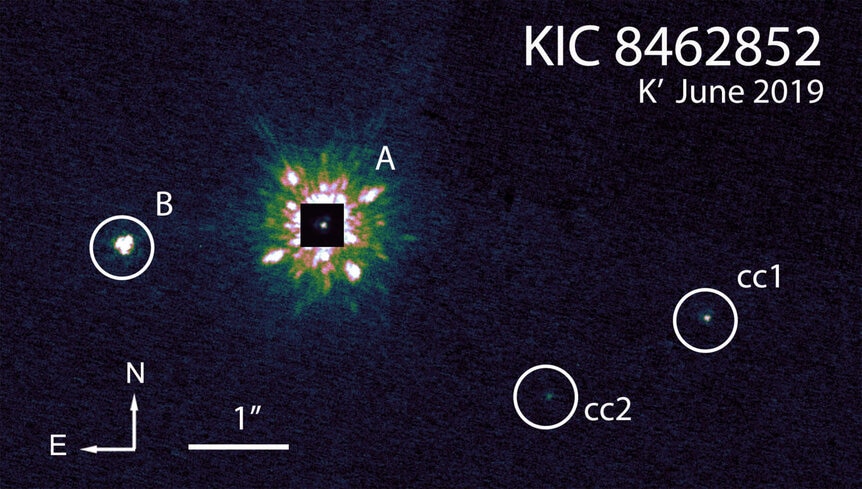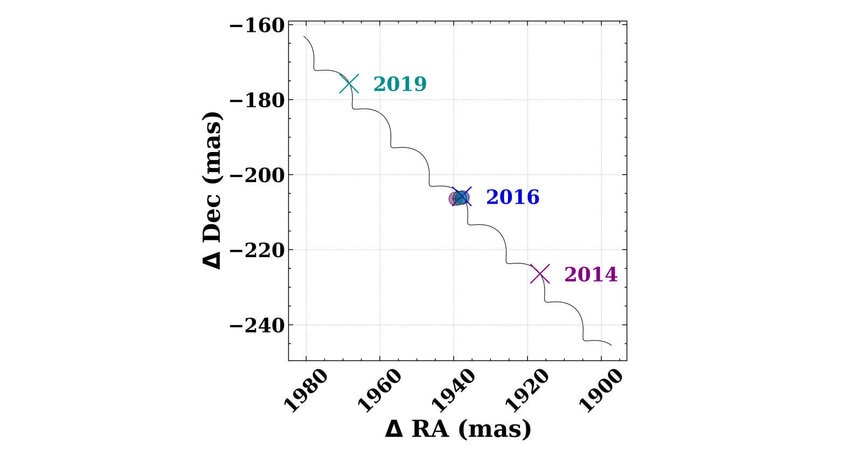Create a free profile to get unlimited access to exclusive videos, sweepstakes, and more!
Another clue for Boyajian's Star: Still not aliens, but maybe a companion

Remember Boyajian's Star (what used to be called Tabby's Star)? This star undergoes episodes of rapid and dramatic drops in brightness that are, even to this day, still unexplained. What made it most famous was the idea that it could be getting blocked by pieces of an alien megastructure being assembled around it.
Oh yeah, that star. The dips we see in the star's brightness are weird, because they appear to be semi-random (if they do happen at regular intervals they're not super strict about it) and sometimes the dips are really deep, like one that bottomed out with a drop of 22% of the star's light.
We see dips in light from stars quite often, for a variety of reasons. Sometimes stars vary in brightness due to internal physics, or because they're dying. Sometimes a planet passes in front of the star as it orbits, creating a mini-eclipse called a transit — this is how most exoplanets are discovered — but even a giant Jupiter-sized planet will only block about 1% of a star's light. Starspots (like sunspots but on another star) take weeks to develop, which is too slow to explain Boyajian's star, and in that case they don't show any evidence of rotating along with the star.
So what does explain this weird star? Clouds of dust? Maaaaaaybe. The color of the star changes slightly during these episodes, consistent with dust reddening the light. There's even an idea that it has planets, and an interaction between them tore a moon away from one, which has dropped down toward the star and is evaporating.
And no, it's not aliens, sadly.
To be honest, no explanation so far explains everything seen, which is frustrating. But a new paper just published has what may be a clue: A faint star seen very close to Boyajian's Star in the sky is actually a true companion to it, meaning the star is a binary, two stars orbiting each other.
Why does this matter? Because it's possible — possible, nothing's proven yet — that the secondary star could drop lots of comets past the brighter one, which might explain its behavior.
Even early on this second star was visible in images. Boyajian's Star is about 1,470 light years from Earth, and is a bit more massive and hotter than the Sun. Just 2 arcseconds away from it (about 1/1000th the size of the full Moon on the sky) is another star, a much fainter red dwarf. Stars like that are common, so it could be just coincidence. How can you tell?
The astronomers in the new work used the massive Keck telescope to observe the stars three times over a span of five years (in 2014, 2016, and 2019). If the red star were in the foreground or background, their individual motions in the galaxy would cause them to move in different directions over time. But if they move together, that would indicate they actually are together in space.
And what they found is that they do indeed move together.
In that diagram, the Xs mark where you'd expect the red dwarf star to be over time if it were a background star. In all three epochs, though, it has barely moved at all relative to the brighter star. Therefore they are moving together through space, indicating they are in fact a couple. [Note two other stars also close by were examined and were found to be background stars.]
There is a little bit of motion, which the authors attribute to either a change in the instrumental configuration in 2015 (so the 2014 measurement is off a bit compared to the later ones), or possibly orbital motion of the two stars around each other from 2016 to 2019. At the distance of the stars, their current separation of 2 arcseconds corresponds to about 130 billion kilometers in real space — 30 times the distance of Neptune from the Sun. And that's at least how far apart they are; if we're seeing them foreshortened because one is farther away than the other they could be an even wider binary.
Still, that's close enough for them to orbit each other — though, to be fair, this doesn't prove they're actually a binary pair. At that separation there's very little orbital motion over just a few years, so it's not possible to know if they do really orbit each other, or what shape that orbit might be.
But if they do, and that orbit is elliptical, say, then as the red dwarf (called the secondary) drops down toward the brighter star (the primary) it could pass through its cometary belt — what we call the Oort cloud and Kuiper Belt. Its gravity could disturb the orbits of these giant iceballs, dropping them toward the primary. When they get close enough they heat up, their ice turns to gas, and dust embedded in that ice is dislodged, forming a cloud around them.
Could this explain Boyajian's Star's odd behavior?
Well, some of it. The dust works well, and this could be a kinda sorta periodic thing as the comets orbit the primary star. It's hard to say. But it's interesting.
Also, other stars have been found exhibiting similar behavior. If it turns out that all (or even most) of them have binary companions, well, that would be interesting, wouldn't it? That's an idea for a grad student looking for a good Master's Degree project! Get that list and start observing.
So really we still don't have a full explanation for this star's odd antics, but more observations, hopefully, will help. Finding more stars like it helps a lot; we can look for similarities and trends. And then, maybe, someday we'll understand this weird star.





























